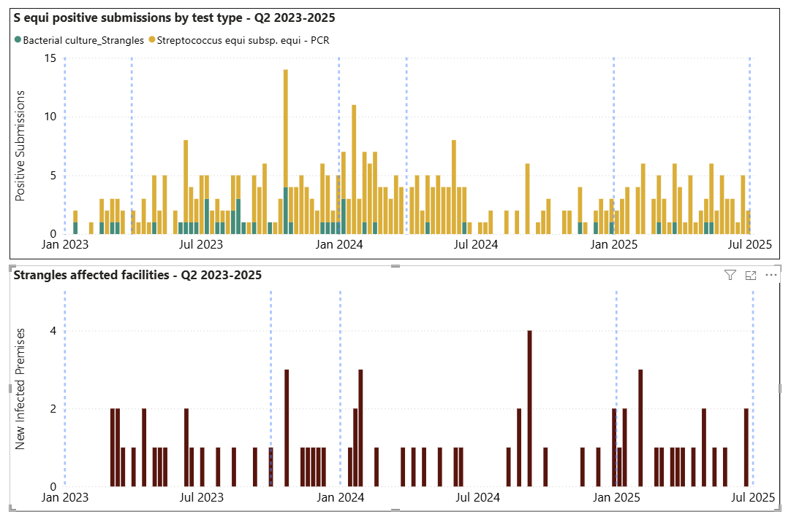Ontario Animal Health Network (OAHN)
Equine Expert Network
Quarterly Owner Report
BITS ‘N SNIPS (or “things we talked about on the network call”)
During our network call we discussed asthma due to wildfire smoke. Just a reminder that there are several resources on the OAHN.ca website that discusses wildfire smoke and horses.
Wildfires and Horse Health – Ontario Animal Health Network
We also discussed contaminated uteri in mares post Cesarian section that were treated with platelet-rich plasma. For more information see:
Cesarean section in 19 mares. Results and postoperative fertility. Juzwiak JS, Slone DE Jr, Santschi EM, Moll HD.Vet Surg. 1990 Jan-Feb;19(1):50-2.
You may have heard that Rocky Mountain Spotted Fever has been diagnosed in dogs that had been to Long Point. This is a zoonotic disease and it can be deadly to both dogs and people. Although horses are not generally thought to develop RMSF, the tick (American Dog tick/ Dermacentor variabilis) can be found on horses in Ontario and horses can be infected by the pathogen, Rickettsia rickettsii. Most infected horses are thought to be asymptomatic, however, there has been one equine case report where RSMF was suspected.
A Suspected Case of Rocky Mountain Spotted Fever in an Adult Horse in the Southeastern United States. Freese S, Sheats MK.J Equine Vet Sci. 2019 Jul;78:134-137.
During most quarters of the year, Ontario veterinarians report seeing horses with “fevers of unknown origin”. Researchers at Cornell university recently looked at the main pathogens in these FUO horses. See the infographic below for a summary of the article.
Although not present this quarter, we briefly discussed the increased number of Potomac Horse Fever cases already showing in Q3. See the infographic below for a summary of an article on Potomac Horse Fever in Ontario.
There was a confirmed case of Pigeon Fever (Corynebacterium pseudotuberculosis) in a pony in Oxford County earlier this year. The pony had shipped up from Florida and the abscess was positive on culture.
Molecular Detection of Pathogens in Equine Fever Cases (Fever of Unknown Origin)
Results from the Equine Fever Diagnostic Panel (EFDP), 2019-2023 Cornell University, Animal Health Laboratory
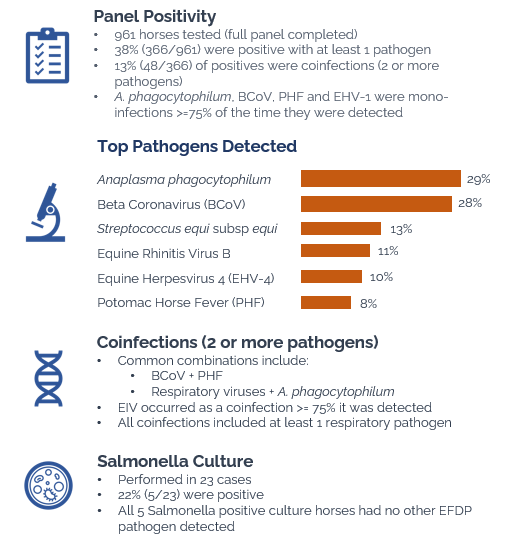
Potomac Horse Fever in Ontario (2015-2019)
Clinical, geographic and diagnostic aspects
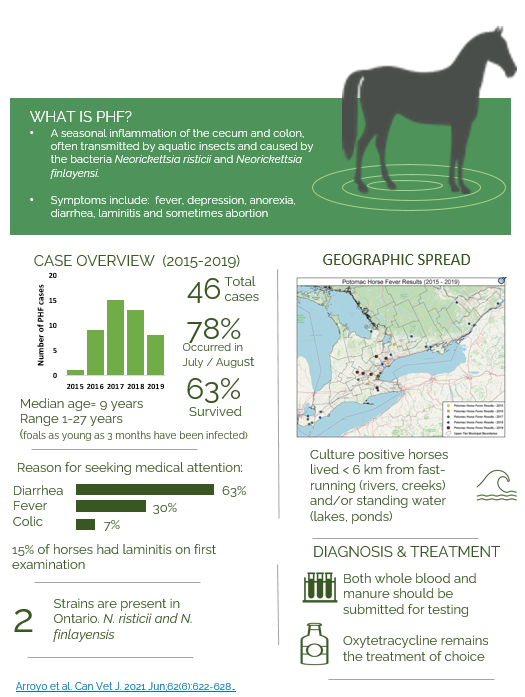
Network Member Reports
| Southwestern Region
(Melissa McKee) |
This quarter we saw significant increase in metabolic-associated laminitis and atypical tying up cases due to environmental conditions and lush pastures, Asthma cases flared due to poor air quality, and moisture- associated dermatitis (pastern dermatitis, vasculitis, rain rot, ) increased. For pastern dermatitis, the leg coverings (e.g. Equi-chaps have been useful). There was a slight increase in the number of surgically significant bone injuries in racehorses and riding horses (P1). It seemed like mares were late to start cycling and breeding back after foaling challenges. Strangles continues to simmer but is not a big concern right now. |
| Southern Ontario
(Jenna Donaldson) |
One thing we all noted this quarter was an increase in umbilical infections . Usually, we have a handful each year and are treated successfully but this year we had refer two for surgery . We didn’t have any multidrug uterine infections this year which was nice. Most MDR uterine infections have been associated with recovery from C-sections. We had two previously which culture Klebsiella sp. and were treated with dilute vinegar lavages and platelet-rick-plasma and both got pregnant the following year with no problem |
| Ontario Veterinary College
(Memo Arroyo) |
This quarter was dominated mostly by foals, postpartum mares, and colics. Happy to see very little hemorrhage post foaling, and not too many retained placentas. But we had a lot of foals; typically septic and NME foals and we saw a little unusual presentation in that foals did not appear systemically septic but had septic joints and/or osteomyelitis. They were difficult to treat as they were not responsive to typical antibiotics. Now doing more resistance studies to see what’s going on. As we move into spring we have had the earliest Neorickettsia (PHF) case yet (beginning of May) and are admitting an increased number of PHF cases. There are a lot of non-PHF colitis cases as well |
| OMAFA
(Bukunmi Odebunmi & Alison Moore) |
Immediately Notifiable Diseases: Case Reports to OMAFA
West Nile Virus: No cases this quarter •First wild bird case 2025: May 26, 2025 (Whitchurch-Stouffville, ON) Eastern Equine Encephalitis virus: No cases the quarter •First equine case 2024: week of July 14th Equine Herpesvirus-1: There were 3 facilities affected by EHM due to EHV-1 in Q2. One 28 yo gelding with acute ataxia that was euthanized (Wellington County, nNP strain), a <24 hour old foal that was born weak an died (Wellington County, nNP strain) and a 3 yo gelding with acute onset ataxia that is recovering (Toronto region, NP strain).
Available from: Equine Disease Tracking Network v 2.1 (arcgis.com)
Strangles: During Q2 there were 7 new facilities managing Strangles for a total of 18 facilities YTD . There were 25 facilities affected by Strangles in 2024.
Available from: Equine Disease Tracking Network v 2.1 (arcgis.com)
Equine Influenza: There were 6 facilities affected by influenza in Q2 in Hastings, Wellington, Essex and Niagara. 5 of the facilities had horses competing in the barrel racing industry.
Q1 Equine Syndromic Surveillance: Graphs of disease syndromes based on samples sent for testing to the Animal Health Laboratory. This information is compiled based on the type of sample, test ordered, and key terms included in the submission history (if provided).
|
Please follow:
Outbreaks | Equine Disease Communication Center (equinediseasecc.org) for reported outbreaks!
Syndromic and AHL Laboratory Data Surveillance
Survey – Key points
- 17 Counties represented
- 69% equine, 15% equine and food animal, 8% equine and small animal, 8% referral practice
- 24% of veterinarians reported working with performance/Competition/Show horses , 22% with pleasure/backyard horses, 18% with foals, breeding and young stock, 14% racehorses, 10% with draft horses, 10% with mules/donkeys, and 2% with buggy horses.
- Increases in Q1 were noted for (foal): umbilical infections
- Increases in Q1 were noted for (adult): Asthma, Strangles, smoke inhalation (wildfires), surgical colics, urticaria. EMS / insulin resistance, FUO, anaplasmosis and Lyme disease, anhydrosis
New conditions or those without a diagnosis:
- Fevers of unknown origin which tested negative for EHV, influenza, anaplasmosis, PHF, coronavirus, hepacivirus, rhinovirus A/B and streptococci sp.
- Two older horses with glaucoma, one of which was likely secondary to ERU and one primary glaucoma.
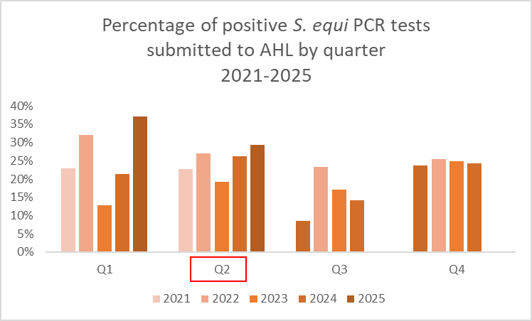
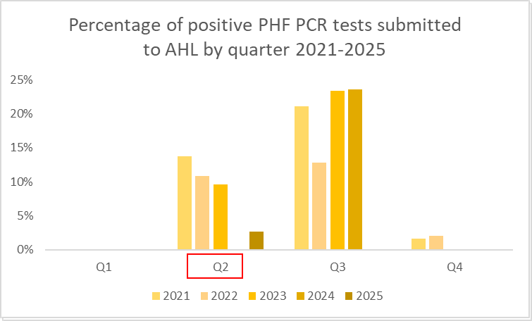
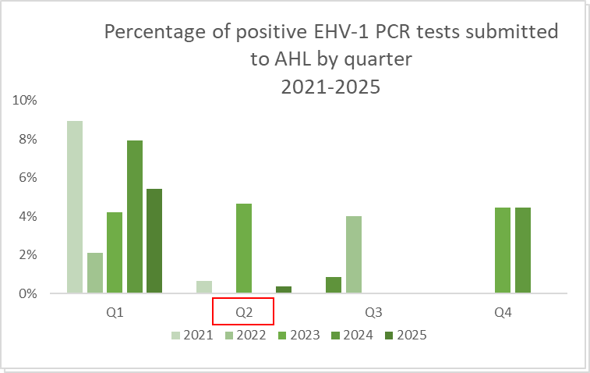
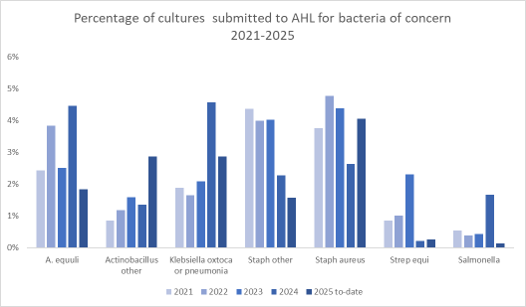
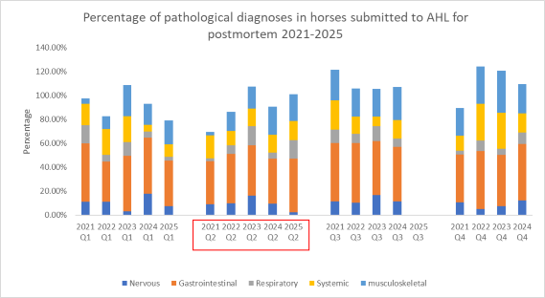
Ontario equine disease surveillance summary
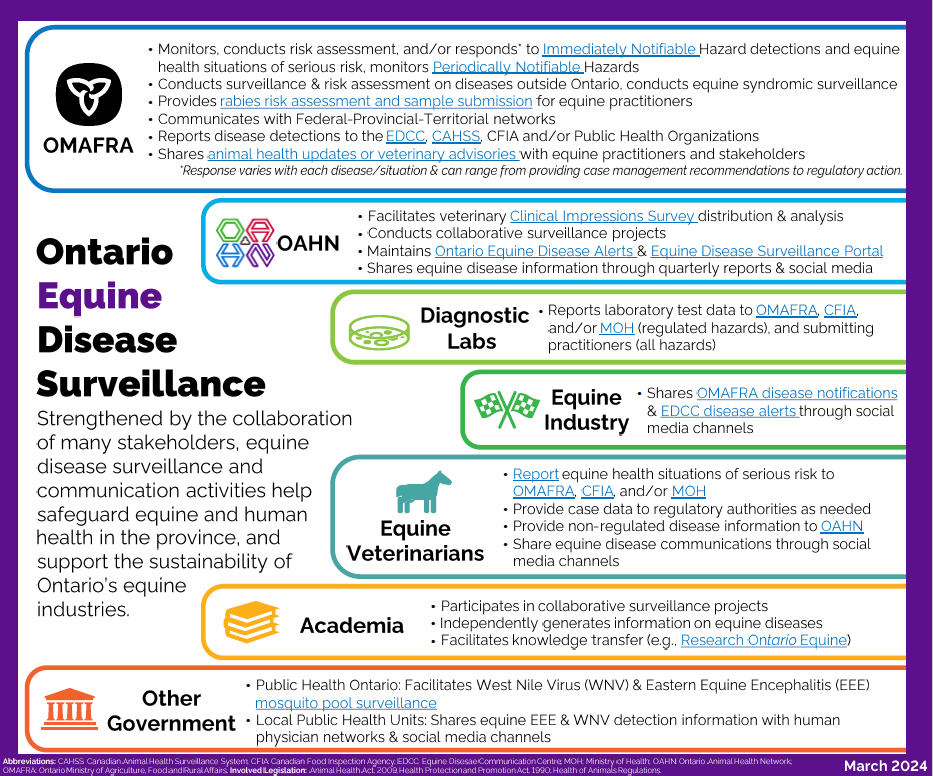
Equine disease surveillance in Ontario is a collaborative effort involving many public and private stakeholders. Diagnostic results generated by veterinary laboratories, clinical impression and case data provided by equine veterinarians, disease detections reported outside of Ontario by independent organizations, vector surveillance conducted by human health agencies, and research projects facilitated by Academic institutions or the Ontario Animal Health Network (OAHN), are all key sources of surveillance data. Strong communication between these stakeholders and with horse owners and caretakers supports both equine and human health in Ontario.
Please follow the links in the summary above for additional information on the associated activities or organizations and for many resources useful to equine industry members.
ResearchONequine.ca is a website developed by the Ontario Animal Health Network equine network to help increase research awareness and to connect researchers from academia, industry and government with the ultimate goal of improving the lives of all equines. It was supported by OAHN and the Ontario Association of Equine Practitioners.
is a website developed by the Ontario Animal Health Network equine network to help increase research awareness and to connect researchers from academia, industry and government with the ultimate goal of improving the lives of all equines. It was supported by OAHN and the Ontario Association of Equine Practitioners.
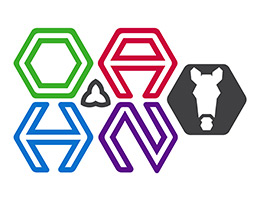



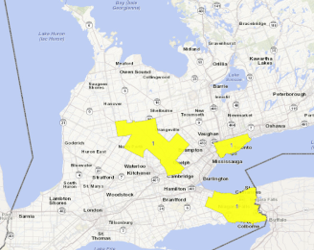 Map of counties with facilities positive for EHV-1 (with EHM) in 2025
Map of counties with facilities positive for EHV-1 (with EHM) in 2025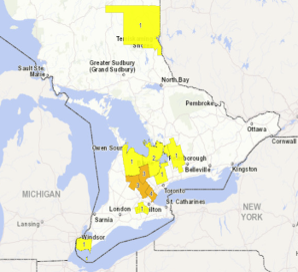 Map of counties with facilities positive for Strangles in 2025.
Map of counties with facilities positive for Strangles in 2025.